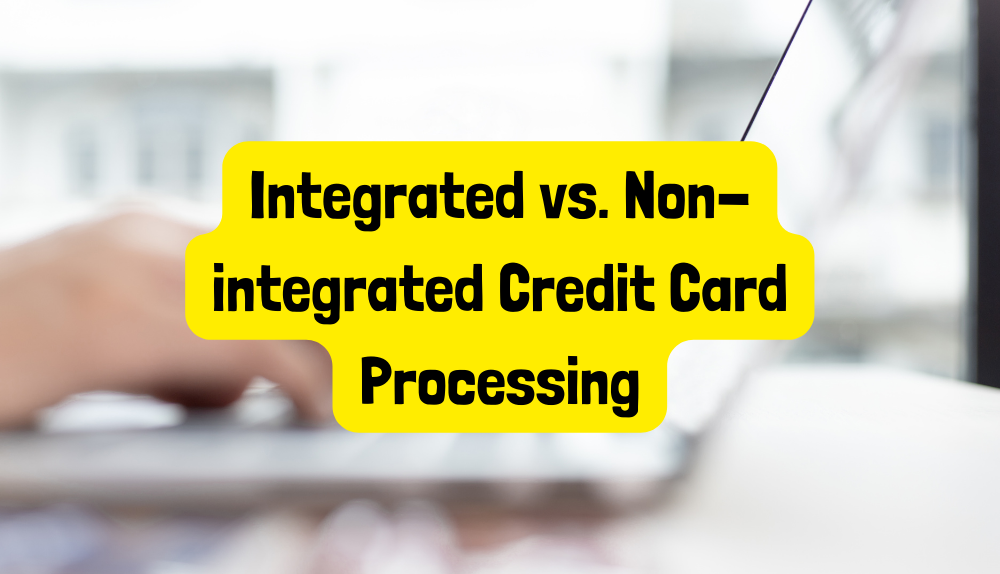
Integrated vs. Non-integrated Credit Card Processing
- 31st May, 2023
- | By max
- | Uncategorized
In the bustling world of commerce, how businesses handle transactions can significantly impact their efficiency, customer experience, and bottom line. The choice between integrated vs non-integrated credit card processing systems may seem technical and complex, yet it carries profound implications for businesses of all sizes.
This decision is not just about technology but streamlining operations, mitigating errors, and enhancing security. This article will cover the key differences between integrated and non-integrated processes and understanding how this choice could elevate your business operations or remove unnecessary hurdles to your daily operations.
Integrated vs Non-integrated Credit Card Processing
Understanding Integrated Credit Card Processing
Definition of Integrated Credit Card Processing
Integrated credit card processing is a system that seamlessly connects accepting credit card payments with the business’s point of sale (POS) system. It allows real-time transaction data communication between a company’s POS and payment processing systems, creating a unified solution within one platform.
Key Characteristics and Functions
Seamless Connectivity: Integrated systems sync all transactions with the POS system in real-time, providing a connected payment experience.
Automation: The system automatically updates sales data, inventory levels, and customer information.
Multichannel Capabilities: Many integrated systems allow businesses to accept in-store, online, and mobile payments.
Flexibility: The system typically processes various payment types, including debit cards, credit cards, and mobile payments.
Benefits of Integrated Credit Card Processing
Streamlined Operations: Integrated systems reduce manual tasks by synchronizing data in real-time. This allows quicker transactions and more efficient operations, enhancing customer experience.
Reduced Errors: Since payment information is entered directly into the system, it reduces the risk of human errors in data entry. Discrepancies in sales records due to mistakes in inputting data are minimized.
Enhanced Security: Integrated systems often have built-in security features to protect sensitive data. Directly entering payment information into the system reduces the risk of fraud or misuse.
Comprehensive Reporting: Integrated systems can provide valuable insights through comprehensive reporting. Businesses can track sales trends, inventory levels, and customer purchasing habits, which can inform strategic decision-making.
Understanding Non-Integrated Credit Card Processing
Definition of Non-Integrated Credit Card Processing
Non-integrated credit card processing involves independent payment terminals not directly connected to a business’s point-of-sale (POS) system. Each transaction must be manually entered into the payment terminal and then separately recorded in the POS or accounting system, creating a two-step process.
Key Characteristics and Functions
Separate Systems: Transactions are processed separately from the business’s POS system, requiring manual data entry.
Independent Terminals: These systems use independent terminals that can accept credit and debit card payments, but these are not linked to other business systems.
Manual Data Entry: Payment information is manually entered into the terminal and then must be manually reconciled with the POS system.
Potential Drawbacks of Non-Integrated Credit Card Processing
More Manual Processes: With non-integrated systems, each transaction requires manual entry into both the payment terminal and the POS system. This can be time-consuming and inefficient, especially during busy periods.
Increased Chance of Errors: Because data must be entered manually, there is a higher chance of human error. This could lead to discrepancies in financial records and inventory data, creating additional issues for the business.
Less Streamlined Reporting: Since payment processing and business systems operate independently, consolidating data for reporting purposes can be more complex and time-consuming. This may limit the ability of businesses to obtain and analyze comprehensive sales data quickly.
Key Differences Between Integrated and Non-Integrated Credit Card Processing
Differences in Operation and Transaction Handling
Integrated systems allow for seamless, automatic data entry and processing within one unified system. In contrast, non-integrated systems require manual data entry into separate systems for payment processing and POS operations.
Transaction transactions are automatically reconciled with integrated systems, while non-integrated systems require manual reconciliation.
Impact on Business Efficiency
Integrated systems enhance efficiency through automation and synchronization capabilities, reducing time-consuming manual processes. Non-integrated systems, on the other hand, require more resources to handle the manual data entry and reconciliation processes.
The streamlined reporting of integrated systems allows for quicker, more informed decision-making. Data consolidation with non-integrated systems is more complex and time-consuming, potentially slowing down business insights and decision-making processes.
Differences in Security Measures
Integrated systems often have robust security features, including encryption and tokenization, to protect sensitive data throughout the transaction process. Non-integrated systems may not provide the same level of comprehensive protection, particularly during the manual data entry process.
Impact on Customer Experience
Integrated systems typically offer customers a faster, more seamless transaction experience, potentially enhancing customer satisfaction. On the other hand, non-integrated systems lead to longer transaction times, which could impact the customer experience, especially during peak business hours.
With their ability to sync customer data and transaction history, integrated systems may provide more opportunities for personalized customer engagement, loyalty programs, and targeted marketing efforts. Due to their manual and separate nature, non-integrated systems may not propose the same level of customer relationship management.
Case Studies and Real-World Examples
Examples of Businesses Using Integrated Credit Card Processing
A modern retail store: Many brick-and-mortar retailers use integrated credit card processing systems, especially online ones. The real-time synchronization between their POS system and their payment processing system allows them to track inventory across multiple channels and provide a seamless customer experience, both in-store and online.
A busy restaurant: Restaurants benefit from integrated credit card processing, especially those using advanced order management systems. The system’s ability to handle split bills, tips, and real-time tab updates while updating inventory and sales data can significantly enhance operational efficiency.
Examples of Businesses Using Non-Integrated Credit Card Processing
A small farmers’ market vendor: Vendors at farmers’ markets or craft fairs, where transaction volume is low, and inventory management is simple, might choose non-integrated systems. These standalone systems can be more cost-effective and straightforward for these small-scale businesses.
A pop-up shop: Non-integrated systems may be suitable for temporary shops that don’t require complex inventory management or sales tracking. They’re portable and easy to set up, allowing businesses to accept card payments without investing in a full-fledged POS system.
Making the Right Choice: Factors to Consider
Business Size and Volume of Transactions
The size of your firm and the number of transactions you process can significantly influence your choice. Due to its efficiency and automated reconciliation, integrated credit card processing is more beneficial for larger businesses or those with high transaction volumes. Smaller businesses or those with lower transaction volumes may find non-integrated systems more cost-effective and easier to manage.
Business Model and Industry
The type of companies you run and your industry can also affect your decision. For instance, businesses with a multichannel model (both online and brick-and-mortar stores) or those in fast-paced industries like food service might benefit more from integrated systems. On the other hand, businesses with simple models, like pop-up shops or vendors at markets, may find non-integrated systems sufficient.
Available Resources and Technical Capabilities
Consider the resources you have to implement and maintain your system, including financial resources, technical skills, and staff time. Integrated systems may require a more significant initial investment and technical ability to set up and manage, but they can save time and reduce errors in the long run. Non-integrated systems are easier and cheaper to implement but require more manual work and carry a higher risk of mistakes.
Long-Term Growth and Scalability
Look ahead to your business’s future. If you plan to grow or scale up your operations, an integrated system could be a wise choice as it can adapt to increasing transaction volumes and provide comprehensive data for decision-making. On the contrary, a non-integrated system may be more appropriate and cost-effective if your operations are likely to remain small-scale or simple.
Importance of Selecting the Right System for Specific Business Needs
Choosing the appropriate credit card processing system is a pivotal decision that can significantly influence the efficiency and success of your business. Factors such as business size, transaction volume, business model, industry, available resources, technical capabilities, and long-term growth plans must all be considered. Both integrated and non-integrated systems have unique strengths and potential drawbacks, so understanding these factors can guide you in choosing a choice that aligns with your business needs and strategic goals. The right system facilitates transactions and improves overall operational effectiveness and customer satisfaction.
Conclusion
Integrated and non-integrated credit card processing systems have distinct features and implications for business operations. Integrated systems offer seamless connectivity, automation, and real-time updates for streamlined operations, reduced errors, enhanced security, and comprehensive reporting. Conversely, non-integrated systems function independently of other business systems, requiring more manual processes, presenting increased chances of mistakes, and providing less streamlined reporting.



